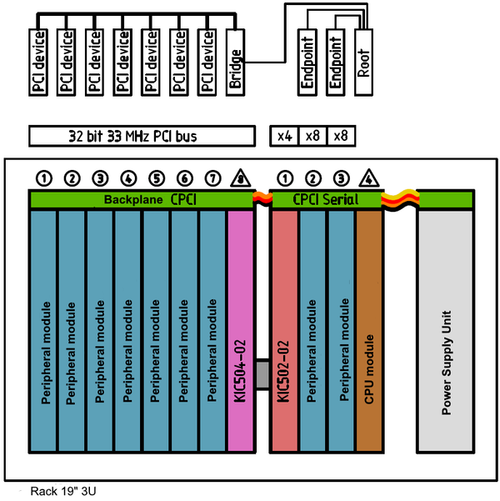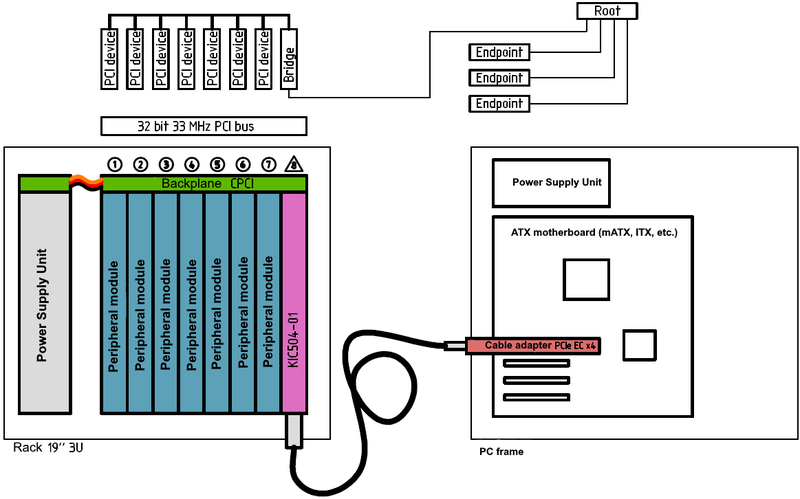17.10.2019
The KIC502 module is a CompactPCI Serial (CPCI-S) host adapter for PCI Express x4 Gen3 cable connection that uses specification PCI Express External Cabling (PCIe EC). The width of the PCIe link to be routed to the cable connection corresponds to the link width of the backplane slot in which the module is installed, but cannot be larger than x4. Up to 8x KIC502-01 modules can be installed into the CPCI-S board in order to extend system capabilities. The terminal device can be any device that supports a PCIe x4 cable connection. The KIC502-02 version is used to extend CPCI-S system within a single frame, without external cable connections.
The KIC502 module can be used to connect a large number of low-speed devices, e.g. to extend the capabilities of the I/O system (serial and parallel ports, analog and digital I/O, etc.), to connect systems using different industrial standards such as CompactPCI, VME, MicroPC, PC/104 and StackPC, etc. The number of the connected external devices is limited only by the size of the memory space for the PCI bus. In order to connect external PCIe devices with power consumption up to 70 watts, the KIC502-01 module is equipped with +12V power connector with overload protection.
KIC504 is PCI Express x4 cable adapter for connection of CompactPCI (CPCI) modules to the system using the PCI Express bus. The adapter is installed in the system slot of the CompactPCI backplane. The module supports connection of up to 7x devices via PCI 32bit 33MHz bus (up to 4 ones with 66 MHz frequency), 4 devices of which can use bus mastering function. The KIC504-01 version uses a cable connection via the PCI Express External Cabling specification, therefore, any system that supports this specification with x4 link width, can act as a host. The KIC504-02 version is used only in conjunction with the KIC502-02 module for connection of CompactPCI modules to CompactPCI Serial system within a single frame.
KIC504 can be used to expand the systems in CopmpactPCI Serial, ATX and other formats due to the modules in CompactPCI format. To connect to the CopmpactPCI Serial system, either KIC502 module, or PCI Express x4 adapters of other manufacturers can be used. There are also PCI Express External Cabling adapters for desktop PCs that, when using the KIC504 module, makes it possible to simplify the adjustment of CompactPCI peripherals.
Application within the Systems
Increasing the Number of Peripheral Modules
Standard CompactPCI Serial backplanes have no more than 8 slots for connecting peripheral modules. If this amount is not enough for building the system, it can be increased by connecting other backplanes with a cable connection. In this case, the backplanes can be placed within the same frame, or in the different ones, installed either in the same 19" rack, or spaced apart at a distance of 7 meters (the maximum allowable length of PCI Express cable).
The PCI Express x4 cable adapter is installed into the processor slot of the additional backplane, which uses the PCI Express switch for activating all the slots of the backplane (see Fig. 1). It is recommended to use KIC502 in the slots with the link width not less than x4. It is allowed to use a lesser link width if its bandwidth is sufficient for normal operation of peripheral modules on an additional backplane.

Figure 1. Expansion of the system by connecting additional modules of CPCI-S format.
Expanding the CPCI-S System Using the CPCI Modules
The first version of the CPCI specification appeared in 1999, and a wide variety of peripheral modules in this format were released over 20 years. Many of them are still used in industrial automation systems that do not require high-speed data exchange, due to its reliability, confirmed by many years of experience. When creating modern automation tools, it is increasingly necessary to receive and process large flows of information, which leads to the choice of the CPCI-S format as the main one for building the system. At the same time, it is still necessary to use some peripheral modules in the CPCI format. Adapters KIC502 and KIC504 can be used to connect these modules to CPCI-S system. If the number of CPCI-S peripheral modules doesn't exceed 3 (or the number of CPCI modules less than 7), the CPCI and CPCI-S backplanes can be placed in a single frame, since the KIC502 and KIC504 modules have the mezzanine connection option. This eliminates the use of an external cable (Fig. 2A). If the CPCI and CPCI-S backplanes need to be placed in different frames, a PCI Express cable connection can be used (Fig. 2B). In this case, several frames with CPCI modules can be connected to the CPCI-S system.

Figure 2A. Mezzanine connection of KIC502 and KIC504.

Figure 2B. Cable connection of KIC502 and KIC504 modules.
Connecting CPCI Modules to PC
In some cases, for example, in order to facilitate the adjustment process, you may need to connect the cPCI peripherals to a PC or other systems that use PCI Express. For these purposes, special adapters can be used, e.g., the ATX cable adapter for connection to a PC, together with the KIC504 module (Fig. 3).

Figure 3. Connecting CPCI modules to PC.
Feeding the Low-Power PCI Express Peripheries
The CPCI - S standard allows power consumption of up to 80 watts for each module installed on the backplane. Since the own consumption of KIC502 is low, up to 75 watts of power can be used in order to supply the system via the PCI Express cable. The external system is powered by a +12V via a separate cable connected to the front panel of KIC502-01. The MicroPC modules, PC/104, Stack, PC, etc. with appropriate adapters for cable connection of PCIe x4 (Fig. 4) can be used as peripherals.

Figure 4. Connection of MicroPC modules using KIC502.
Summary
KIC502 and KIC504 can be used as a cost-effective solution to extend CPCI-S systems through cPCI peripherals. In addition, they can be utilized for other inter-system connections via PCI Express x4 cable. Since the most modern operating systems have standard built-in tools for working with the PCI bus, Including PCIe -> PCI bridges, the use of these modules does not require installation of any additional drivers or system configurations. The expansion of the system is limited only by the available size of the address space for the PCI bus.

.png)

























